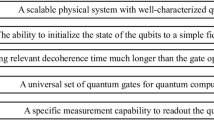Abstract
A discrete-time quantized-state Hopfield neural network is analyzed with special emphasis in its convergence, complexity and scalability properties. This network can be considered as a generalization of the Hopfield neural network by Shrivastava et al. [27] into the interior of the unit hypercube. This extension allows its use in a larger set of combinatorial optimization problems and its properties make of it a good candidate to build hybrid algorithms along with other heuristics such as the evolutive algorithms. Finally, the network is illustrated in some instances of the linear assignment problem and the frequency assignment problem.
Similar content being viewed by others
References
S. Abe, Global convergence and suppression of spurious states of the Hopfield Neural Networks, IEEE Trans. Circuits Syst. 40(4) (1993) 246–257.
S.V.B. Aiyer, M. Niranjan and F. Fallside, A theoretical investigation into the performance of the Hopfield model, IEEE Trans. Neural Networks 1(2) (1990) 204–216.
J. Balicki, A. Stateczny and B. Zak, Genetic algorithms and Hopfield neural networks for solving combinatorial optimization problems, Appl. Math. Comput. Sci. 7(3) (1997) 567–592.
F. Barahona, On the computational complexity of Ising spin glass models, J. Phys. A: Math. General 15(10) (1982) 815–826.
J. Bruck and J.W. Goodman, A generalized convergence thorem for neural networks, IEEE Trans. Inform. Theory 34(5) (1988) 1089–1092.
M.A. Cohen and S. Grossberg, Absolute stability of global pattern formation and parallel memory storage by competitive neural networks, IEEE Trans. Systems, Man Cybernetic 13(5) (1983).
F. Fabris and G.D. Riccia, An application of the Hopfield model to huffman codes, IEEE Trans. Inform. Theory 39(3) (1993) 1071–1076.
N. Funabiki, N. Okutani and S. Nishikawa, A three-stage heuristic combined neural-network algorithm for channel assignment in cellular mobile systems, IEEE Trans. Vehicular Technol. 49(2) (2000) 397–403.
N. Funabiki and Y. Takefuji, A neural network parallel algorithm for channel assignment problems in cellular radio networks, IEEE Trans. Vehicular Technol. 41(4) (1992) 430–437.
S. Geman and D. Geman, Stochastic relaxation, Gibbs distributions and the Bayesian restoration of images, IEEE Trans. Pattern Anal. Machine Intell. 6(6) (1984) 721–741.
R.M. Golden, Mathematical Methods for Neural Network Analysis and Design(MIT Press, Cambridge, MA, 1996).
A. Haken and M. Luby, Steepest descent can take exponential time for symmetric connectionist networks, Complex Systems 2(2) (1988) 191–196.
J.K. Hao, R. Dorne and P. Galinier, Tabu search for frequency assignment in mobile radio networks, J. Heuristics 4(1) (1998) 47–62.
N. Hartsfield and G. Ringel, Pearls in Graph Theory. A Comprehensive Introduction(Academic Press, San Diego, CA, 1994).
J.J. Hopfield, Neural networks and physical systems with emergent collective computational abilities, Proc. Natl. Acad. Sci. USA Biophys. 81 (1984) 3088–3092.
J.J. Hopfield, Neurons with graded response have collective computational properties like those of two-states neurons, Proc. Natl. Acad. Sci. USA Biophys. 79 (1982) 2554–2558.
J.C. Juang, Stability analysis of Hopfield-type neural networks, IEEE Trans. Neural Networks 10(6) (1999) 1366–1374.
H.W. Khun, The hungarian method for the assignment problem, Naval Research Logistics Quarterly 2(83) (1955).
P.Koiran, Dynamics of discrete time, continuous state Hopfield networks, Neural Comput. 6(3) (1994) 459–468.
W.K. Lai and G.C. Coghill, Channel assignment through evolutionary optimization, IEEE Trans. Vehicular Technol. 45(1) (1996) 91–96.
S. Matsuda, “Optimal” Hopfield network for combinatorial optimization with linear cost function, IEEE Trans. Neural Networks 9(6) (1998) 1319–1330.
S. Matsuda, Quantized Hopfield networks for integer programming, Systems Comput. Japan 6 (1999) 1–12.
S. Matsuda, Theoretical analysis of quantized Hopfield network for integer programming, in: Proc. of the IEEE International Joint Conference on Neural Networks(1999) pp. 568–571.
Neurocomputing 8, Special Issue on Optimization and Combinatorics (1995).
I. Parberry, Scalability of a neural network for the knight's tour problem, Neurocomputing 12 (1996) 19–34.
S. Salcedo-Sanz, C. Bousoño-Calzón and A.R. Figueiras-Vidal, A mixed neural-genetic algorithm for the broadcast scheduling problem, IEEE Trans. Wireless Commun. 2(2) (2003) 277–283.
Y. Shrivastava, S. Dasgupta and S.M. Reddy, Guaranteed convergence in a class of Hopfield networks, IEEE Trans. Neural Networks 3(6) (1992) 951–961.
J. Sima, P. Orponen and T. Antti-Poika, On the computational complexity of binary and analog symmetric Hopfield nets, Neural Comput. 12(12) (2000) 2965–2989.
K.Y. Siu, V. Roychowdhury and T. Kailath, Discrete Neural Computation. A Theoretical Foundation(Prentice Hall, Englewood Cliffs, NJ, 1995).
A.M. Stuart and A.R. Humphries, Dynamical Systems and Numerical Analysis(Cambridge University Press, Cambridge, UK, 1998).
C. Voudouris and E.P.K. Tsang, Solving the radio link frequency assignment problem using guided local search proceedings, in: Proc. of NATO Symposium on Radio Length Frequency Assignment, Sharing and Conservation Systems (Aerospace), Aalborg, Denmark (October 1998).
Y. Watanabe, N. Mizuguchi and Y. Fujii, Solving optimization problems by using a Hopfield neural network and genetic algorithm combination, Systems Comput. Japan 29(10) (1998) 68–74.
W.J. Wolf, Inhibitory grids and the assignment problem, IEEE Trans. Neural Networks 4(2) (1993) 319–331.
Author information
Authors and Affiliations
Corresponding author
Rights and permissions
About this article
Cite this article
Bousoño-Calzón, C., Salcedo-Sanz, S. A Discrete-Time Quantized-State Hopfield Neural Network. Annals of Mathematics and Artificial Intelligence 42, 345–367 (2004). https://doi.org/10.1023/B:AMAI.0000038311.03614.f0
Issue Date:
DOI: https://doi.org/10.1023/B:AMAI.0000038311.03614.f0




